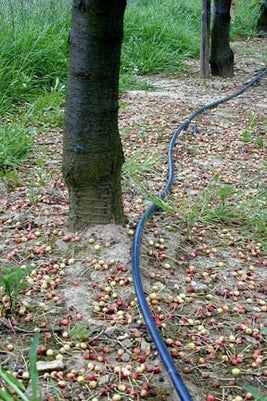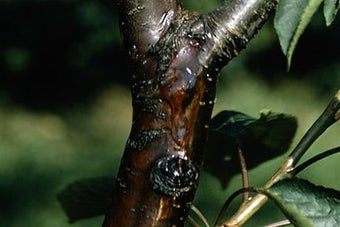
Quick facts
Common name - Cherry run off
Scientific name - None
Plants affected - Sweet cherries
Main symptoms - Much of the cherry crop falls from the tree before ripening
Main causes - Adverse weather in some seasons
Timing - Summer (before ripening)
What is cherry fruit drop?
Many members of the Prunus group, such as apricots and almonds, shed fruit that they do not have resources to bear. This fruit drop can severely reduce the harvest. In Britain, the most common fruit to suffer is the sweet cherry and this is referred to as cherry run off.
- The extent of cherry run off varies from year to year, but can be significant for gardeners and growers alike
- In 2000 in the UK, for example, as much as 90 percent of fruit that initially set on sweet cherries was lost before maturity
- The severity of the drop also varies between geographical location (e.g. cherries in northern areas such as the UK or Norway, suffer more than those grown in the south of Europe or the USA) and within species (there is some preliminary data suggesting that some cherry rootstocks and varieties may be less affected)
It is worth noting that similar problems occur with other fruits, for example in apples the issue is known as .
Symptoms
As ripening becomes imminent much, and often most, of the fruit falls to the ground. The fruit is immature, so can't be eaten.
Control
Pruning
- Pruning trees to give an open canopy is one potential remedy. This maximises light to the leaves, and thereby increases the photosynthetic rate, so is likely to minimise fruit drop
- Where run off is a recurring problem consider altering pruning regimes to allow more space between branches
Fruit thinning
- Reduce the number of fruits, when there are more than 10 per spur, to help matters. Carry out this task when the fruitlets are less than 5mm (¼in) in diameter – usually when petals are still present and before the pit hardens
- the cherries will create a balance between the supporting leaf-area and the fruit, increasing fruit retention. However, it is not possible to give clear guidance on how to strike this balance at present because more research is needed
Alternative measures
- Use light-reflecting mulches such as pale woodchip beneath the tree
- Grow against a sunny wall or by a light coloured path
Causes
Recent research suggests that, in sweet cherry at least, a combination of climatic factors can be linked to heavier fruit drop. They include:
- Poor weather (and low light intensity) at blossom time
- Low temperatures in the early stages of fruit development
- Fruit yields were lower following wet and cold autumns. This is presumably because the trees accumulated less energy reserves to support fruit growth in early spring (before the new leaves can supply sufficient resources)
- Further research suggests that when the leaves send insufficient 'food' (photosynthetic products) to the fruit this results in an imbalance in the within the fruit and this leads to fruit drop
Acknowledgements
This profile is based on research carried out at East Malling Research by Dr Tijana Blanusa and Dr Mark Else. Dr Blanusa is currently the >RHS Plant Physiologist.
Pictures are by kind permission of Dr Else





